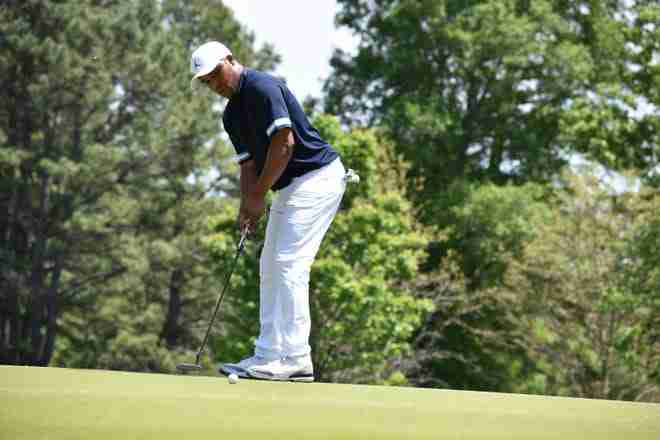
CHARLOTTE – After learning he and Tiger Woods tied in two rounds of this weekend’s Wells Fargo Championship, all Harold Varner III could offer was a wry smile.
“Who knows, maybe we can both be in the same group this weekend,” the Forestview High senior joked after Friday’s round of play. “That would be something, I’ll tell you.”
That duo didn’t materialize during Saturday’s round of golf at Quail Hollow Golf Club in Charlotte. But it wouldn’t have been the first time Woods and Varner were mentioned in the same breath.
A golf prodigy, Varner often made comparisons to the golf phenom as he rose through the professional ranks. Part of it was his abilities on the golf course, part of it was the color of his skin.
The Gastonia native never wanted to be portrayed as “a black golfer,” wanting to stand out more through his game. However, his close family and friends have long made it clear to him that this is not something that he could control.
“I told him, ‘No matter what you think, you’ll always be considered a black golfer,'” said Nate Parker, a longtime family friend. “Even if you don’t want to be seen as such, it’s something you can’t help.”
Only 28 African-American players have competed on the PGA Tour in its history. The first was Charles Sifford, who first gained acclaim as a caddy on courses in North Carolina.
In 1957, he qualified for and won the Long Beach Open, an event co-sponsored by the PGA. Four years later he was allowed to become a full member of the tour.
His first victory as a full member came in 1967, when he won the Greater Hartford Open. Sifford would achieve another tour victory two years later, winning the Los Angeles Open.
Although he broke new ground for players of color, there was one thing Sifford was unable to accomplish: a victory in the Masters Tournament.
It was Woods who broke that barrier, winning the first of his four green jackets in 1997. A career Grand Slam winner, he is second all-time in majors (14) and PGA Tour victories (79).
Oddly enough, Varner made history by becoming the first black golfer to earn his PGA Tour card through the Web.com Tour money list.
His only victory since joining the professional tour came in December 2016, when he won the Australian PGA Championship. Co-sponsored by the European Tour and the PGA Tour of Australasia, he became the second American to win the tournament and the first since Hale Irwin in 1978.
“We always told him he was supposed to be next,” Parker said. “(Varner) is supposed to be the ‘next Tiger Woods,’ we always thought he had that potential.”
The two have crossed paths several times, the first time several years ago at the Wells Fargo Championship during which Varner recalls that Woods did not autograph one of his hats. In recent years, relations have warmed up a little, they share texts.
While wanting to forge his own path in golf, Varner certainly hopes to emulate Woods’ success – in his own way.
“Yeah, he’s the best player I’ve ever seen, so why not look up to the best player?,” the Gastonia native said. “I mean, even if he’s black. I mean, I understand he’s black, but if he was green, I’d be like, “What about Tiger, dude?” That’s how I was raised, I don’t know. But he’s really good.
“I played with Steve Stricker, I think he makes some amazing putts. I think Paul Casey is amazing. I’ve never played with Tiger, so I don’t think I’d want to drive it like him based on TV. When I drive it well, I would like to drive it like me. It’s just to be honest.

